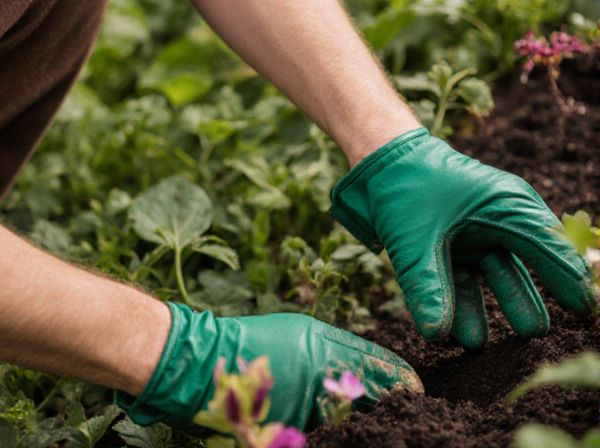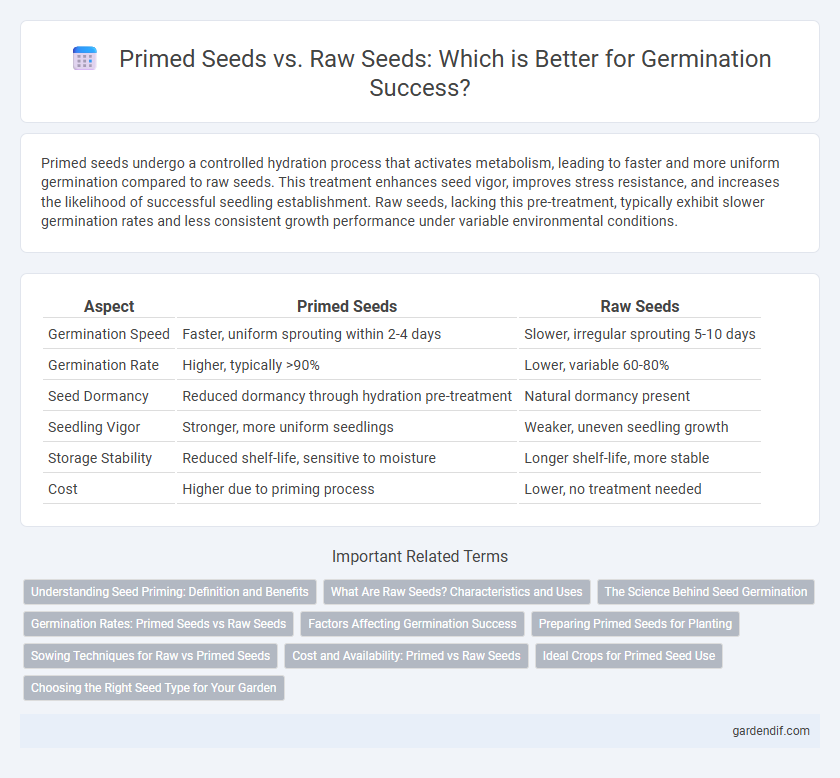
Primed Seeds vs Raw Seeds Illustration
Primed seeds undergo a controlled hydration process that activates metabolism, leading to faster and more uniform germination compared to raw seeds. This treatment enhances seed vigor, improves stress resistance, and increases the likelihood of successful seedling establishment. Raw seeds, lacking this pre-treatment, typically exhibit slower germination rates and less consistent growth performance under variable environmental conditions.
Table of Comparison
| Aspect | Primed Seeds | Raw Seeds |
|---|---|---|
| Germination Speed | Faster, uniform sprouting within 2-4 days | Slower, irregular sprouting 5-10 days |
| Germination Rate | Higher, typically >90% | Lower, variable 60-80% |
| Seed Dormancy | Reduced dormancy through hydration pre-treatment | Natural dormancy present |
| Seedling Vigor | Stronger, more uniform seedlings | Weaker, uneven seedling growth |
| Storage Stability | Reduced shelf-life, sensitive to moisture | Longer shelf-life, more stable |
| Cost | Higher due to priming process | Lower, no treatment needed |
Understanding Seed Priming: Definition and Benefits
Seed priming is a controlled hydration process that initiates seed metabolism without allowing radicle emergence, enhancing germination speed and uniformity. Primed seeds often exhibit improved stress tolerance, higher germination rates, and better seedling vigor compared to raw seeds. This technique optimizes water uptake and activates enzymatic activities, leading to faster and more synchronized seedling development.
What Are Raw Seeds? Characteristics and Uses
Raw seeds are untreated seeds in their natural state, retaining their original seed coat and moisture levels, which often results in longer germination times compared to primed seeds. These seeds exhibit resilience to environmental stress and are preferred for traditional planting practices where natural growth conditions are emphasized. Raw seeds are commonly used in organic farming and restoration projects due to their unaltered genetic integrity and adaptability to various soil types.
The Science Behind Seed Germination
Primed seeds undergo a controlled hydration process that activates metabolic pathways essential for rapid and uniform germination, enhancing enzyme activity and energy production compared to raw seeds. Raw seeds require longer imbibition periods to trigger enzymatic functions, resulting in slower germination and increased vulnerability to environmental stress. This physiological advancement in primed seeds improves germination rates by optimizing cellular repair and hormone regulation during early seed development.
Germination Rates: Primed Seeds vs Raw Seeds
Primed seeds exhibit significantly higher germination rates compared to raw seeds due to enhanced metabolic activation and faster water uptake during the sowing process. Studies show primed seeds can achieve germination rates up to 90-95%, whereas raw seeds often range between 60-75%, directly impacting crop uniformity and yield potential. The controlled hydration in seed priming helps overcome dormancy and improves seed vigor, leading to more consistent and rapid seedling emergence.
Factors Affecting Germination Success
Seed germination success depends heavily on seed treatment, with primed seeds showing faster and more uniform germination compared to raw seeds due to controlled pre-sowing hydration processes. Environmental factors such as temperature, moisture availability, and oxygen levels significantly influence the metabolic activities essential for both primed and raw seeds to initiate germination. Seed dormancy mechanisms present in raw seeds often require specific environmental cues or scarification, whereas primed seeds overcome physiological dormancy more efficiently, enhancing overall germination rates.
Preparing Primed Seeds for Planting
Primed seeds undergo controlled hydration to initiate metabolic processes without germination, enhancing uniformity and speed upon planting. This pre-treatment improves germination rates, especially under suboptimal conditions, by activating enzymes and repairing cellular damage. Proper drying and storage after priming ensure seed viability and facilitate easier handling during planting.
Sowing Techniques for Raw vs Primed Seeds
Primed seeds exhibit faster and more uniform germination due to pre-soaking treatments that activate metabolic processes, making them ideal for direct sowing in well-prepared seedbeds. Raw seeds often require careful soil moisture management and precise sowing depth to ensure adequate water absorption and avoid uneven germination. Selecting appropriate sowing techniques tailored to seed type enhances emergence rates and seedling vigor, optimizing crop establishment.
Cost and Availability: Primed vs Raw Seeds
Primed seeds often have higher upfront costs due to the additional treatment processes but offer improved germination rates and uniform growth, which can reduce long-term cultivation expenses. Raw seeds are usually more widely available and less expensive initially but may result in lower and less predictable germination, potentially increasing the need for reseeding and labor. Farmers must balance the cost-efficiency of primed seeds against the accessibility and immediate affordability of raw seeds when planning crop production.
Ideal Crops for Primed Seed Use
Primed seeds significantly enhance germination speed and uniformity, making them ideal for high-value crops such as tomatoes, peppers, and cucumbers, where early and synchronized emergence is critical. They are also beneficial for crops sensitive to environmental stress, including carrots and lettuce, as priming improves seed vigor and stress tolerance. In contrast, raw seeds may suffice for robust, field-tolerant crops like corn and wheat, where uniform germination is less critical.
Choosing the Right Seed Type for Your Garden
Primed seeds undergo pre-germination treatment, enhancing water absorption and accelerating germination rates compared to raw seeds. They provide uniform growth and higher success rates, making them ideal for gardeners seeking faster results and reliable plant establishment. Raw seeds, while natural and untreated, may require longer germination periods and are better suited for gardeners preferring traditional methods or budget-friendly options.
Primed Seeds vs Raw Seeds Infographic

 gardendif.com
gardendif.com